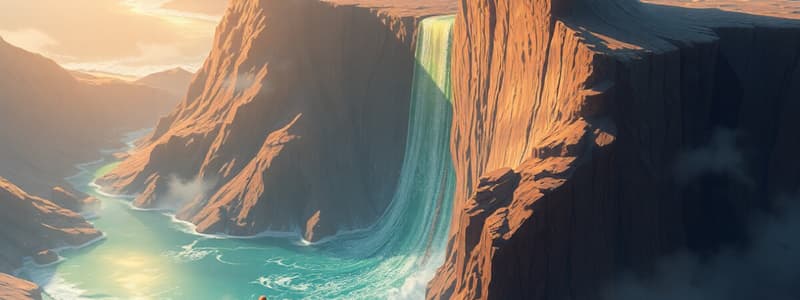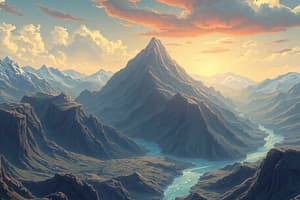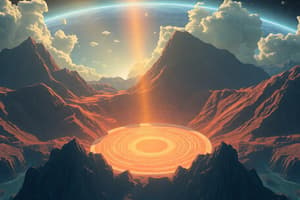Podcast
Questions and Answers
An earthquake is caused by the release of stress accumulated along geologic faults or by ______ activity.
An earthquake is caused by the release of stress accumulated along geologic faults or by ______ activity.
volcanic
The point on Earth’s surface directly above the focus of an earthquake is known as the ______.
The point on Earth’s surface directly above the focus of an earthquake is known as the ______.
epicenter
The ______ is the point of origin of an earthquake within the Earth.
The ______ is the point of origin of an earthquake within the Earth.
focus
[Blank] lines are half circles joining at the poles, used to measure the distance east or west of the prime meridian.
[Blank] lines are half circles joining at the poles, used to measure the distance east or west of the prime meridian.
The Earth's ______ is a thick shell of dense, rocky matter surrounding the core, composed mainly of magnesium-iron silicate minerals.
The Earth's ______ is a thick shell of dense, rocky matter surrounding the core, composed mainly of magnesium-iron silicate minerals.
[Blank] explains phenomena like seismicity and continental drift through the movement and interaction of lithospheric plates.
[Blank] explains phenomena like seismicity and continental drift through the movement and interaction of lithospheric plates.
A ______ is where continents collide, creating mountains.
A ______ is where continents collide, creating mountains.
In a ______, the denser oceanic crust is forced under the continental crust, leading to the formation of mountains and volcanoes.
In a ______, the denser oceanic crust is forced under the continental crust, leading to the formation of mountains and volcanoes.
[Blank] lines are parallel circles measuring the distance north or south of the equator.
[Blank] lines are parallel circles measuring the distance north or south of the equator.
[Blank] are seismic body waves transmitted by sideways movements in a solid and are transverse waves.
[Blank] are seismic body waves transmitted by sideways movements in a solid and are transverse waves.
[Blank] are seismic body waves transmitted by alternating pulses of compression and expansion and are longitudinal waves.
[Blank] are seismic body waves transmitted by alternating pulses of compression and expansion and are longitudinal waves.
A ______ is used to measure and record the vibrations produced by earthquakes.
A ______ is used to measure and record the vibrations produced by earthquakes.
The ______ scale is a logarithmic way to measure the intensity of an earthquake.
The ______ scale is a logarithmic way to measure the intensity of an earthquake.
The ______ is the distance from the center of a circle to any point on its circumference.
The ______ is the distance from the center of a circle to any point on its circumference.
A ______ is a transference of energy.
A ______ is a transference of energy.
Flashcards
Earthquake
Earthquake
A sudden movement of the earth's crust caused by the release of stress or volcanic activity.
Epicenter
Epicenter
The point on Earth's surface directly above the focus of an earthquake.
Focus
Focus
The point of origin of an earthquake within the Earth.
Longitude
Longitude
Signup and view all the flashcards
Mantle
Mantle
Signup and view all the flashcards
Plate Tectonics
Plate Tectonics
Signup and view all the flashcards
Continental Collision Zone
Continental Collision Zone
Signup and view all the flashcards
Subduction Zone
Subduction Zone
Signup and view all the flashcards
Latitude
Latitude
Signup and view all the flashcards
S-waves
S-waves
Signup and view all the flashcards
P-waves
P-waves
Signup and view all the flashcards
Seismograph
Seismograph
Signup and view all the flashcards
Richter Scale
Richter Scale
Signup and view all the flashcards
Wave
Wave
Signup and view all the flashcards
Study Notes
- Earthquake: Sudden Earth's crust movement from stress release along geologic faults or volcanic activity.
- Epicenter: Earth's surface point directly above the earthquake's focus.
- Focus: The origin point of an earthquake.
- Longitude: Part of a grid describing Earth positions; measurement (in degrees) of a place's distance east or west of the prime meridian (Greenwich, England).
- Mantle: Thick shell of dense, rocky matter surrounding Earth’s core, typically 35km to 2900km below the surface.
- It's ductile and mainly composed of magnesium-iron silicate minerals like olivine, with a partially-molten upper section that is the source of magma and volcanic lava.
- Plate Tectonics: Theory explaining global distribution of geological events like seismicity, volcanism, continental drift through lithospheric plate formation, movement and interaction.
- Continental Collision Zone: Convergent plate boundary where colliding continents create mountains.
- Subduction Zone: Area where oceanic and continental crust collide so denser oceanic crust subducts under continental crust, forming mountains and volcanoes.
- Latitude: Part of a grid describing Earth positions; measurement (in degrees) of a place's distance north or south of the equator.
- S-waves (Shear or Secondary waves): Seismic body waves transmitted through sideways movements in a solid which are transverse waves.
- P-waves (Primary waves): Seismic body waves transmitted by alternating compression and expansion (push-pull) are longitudinal waves whose oscillations are parallel to wave direction.
- Seismograph: Instruments measuring and recording earthquake vibrations.
- Richter Scale: Logarithmic scale (1 to 10) indicating earthquake intensity.
- Radius: Distance from circle's center to any point on its circumference.
- Wave: Transference of energy.
Studying That Suits You
Use AI to generate personalized quizzes and flashcards to suit your learning preferences.
Description
Key concepts about earthquakes, their causes, and related geological phenomena. This includes plate tectonics, continental collision zones, and subduction zones. Also includes related terms like focus, epicenter, and mantle.




